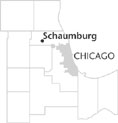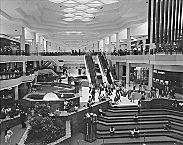| Entries |
| S |
|
Schaumburg, IL
|
 25 miles NW of the Loop. Schaumburg differs from many of the other northwestern suburban towns in that itdid not start around a
railroad
depot. The area, which was very marshy, attracted its first settlers from eastern states in the mid-1830s. Trum- bull Kent of Oswego County, New York, was the first
Yankee
arrival. He was soon joined not only by other easterners but also by
Germans,
many of whom came from Schaumburg-Lippe, between Dortmund and Hannover. They settled along the Chicago–Elgin Road (Irving Park) and other local highways.
25 miles NW of the Loop. Schaumburg differs from many of the other northwestern suburban towns in that itdid not start around a
railroad
depot. The area, which was very marshy, attracted its first settlers from eastern states in the mid-1830s. Trum- bull Kent of Oswego County, New York, was the first
Yankee
arrival. He was soon joined not only by other easterners but also by
Germans,
many of whom came from Schaumburg-Lippe, between Dortmund and Hannover. They settled along the Chicago–Elgin Road (Irving Park) and other local highways.
These farmers organized a German Lutheran congregation as early as 1840, and in 1847 they built their first church. A few years later there was a controversy over the name for the little town that was emerging near the church; some wanted it to be Lutherville, but in the end it became known as Schaumburg Center. It grew very slowly, for the area, though fertile, was swampy, and there was no railroad depot to open the communications with Chicago and stimulate rapid growth.
By the end of the nineteenth century the population of the whole township was only about 1,000. The township, which by 1900 boasted three cheese factories, continued to grow very slowly during the first half of the twentieth century, as did the little town.

|
I-290 came to border Schaumburg to the east, cutting it off from the forests and sloughs of the Ned Brown Forest Preserve; to the north it extended as far as the old Algonquin Road, once an Indian trail and then the route of the Chicago–Galena stagecoach. In the northeastern area emerged Woodfield Mall, opened in 1971 and one of the region's largest shopping centers. It was not by chance that the mall developed close by both I-290 and the Northwest Tollway. While Schaumburg's dramatic growth came with the automobile, the community now has a rail depot and is a regional public transportation center. Schaumburg today is a mature community, with a small industrial area in its southwestern section and a great variety of churches, schools, and open places. Its German origins are now muted, though they live on in road names like “Biesterfield.”
While Woodfield defines Schaumburg to outsiders, residents have returned to the old crossroads at Plum Grove and Schaumburg Roads to develop a new town center in the 1990s. Local shopping, a public library, public recreational facilities, the government center, and a bandstand now provide residents with a service core.
| Schaumburg, IL (inc. 1956) | |||||
| Year |
Total
(and by category) |
Foreign Born | Native with foreign parentage | Males per 100 females | |
| 1960 | 986 | — | — | — | |
| 1990 | 68,586 | 9.6% | — | 95 | |
| 62,156 | White (90.6%) | ||||
| 1,487 | Black (2.2%) | ||||
| 38 | American Indian (0.1%) | ||||
| 4,414 | Asian/Pacific Islander (6.4%) | ||||
| 491 | Other race (0.7%) | ||||
| 1,649 | Hispanic Origin* (2.4%) | ||||
| 2000 | 75,386 | 18.9% | — | 95 | |
| 59,391 | White alone (78.8%) | ||||
| 2,526 | Black or African American alone (3.4%) | ||||
| 77 | American Indian and Alaska Native alone (0.1%) | ||||
| 10,697 | Asian alone (14.2%) | ||||
| 43 | Native Hawaiian and Other Pacific Islander alone (0.1%) | ||||
| 1,307 | Some other race alone (1.7%) | ||||
| 1,345 | Two or more races (1.8%) | ||||
| 3,988 | Hispanic or Latino* (5.3%) | ||||
The Encyclopedia of Chicago © 2004 The Newberry Library. All Rights Reserved. Portions are copyrighted by other institutions and individuals. Additional information on copyright and permissions.